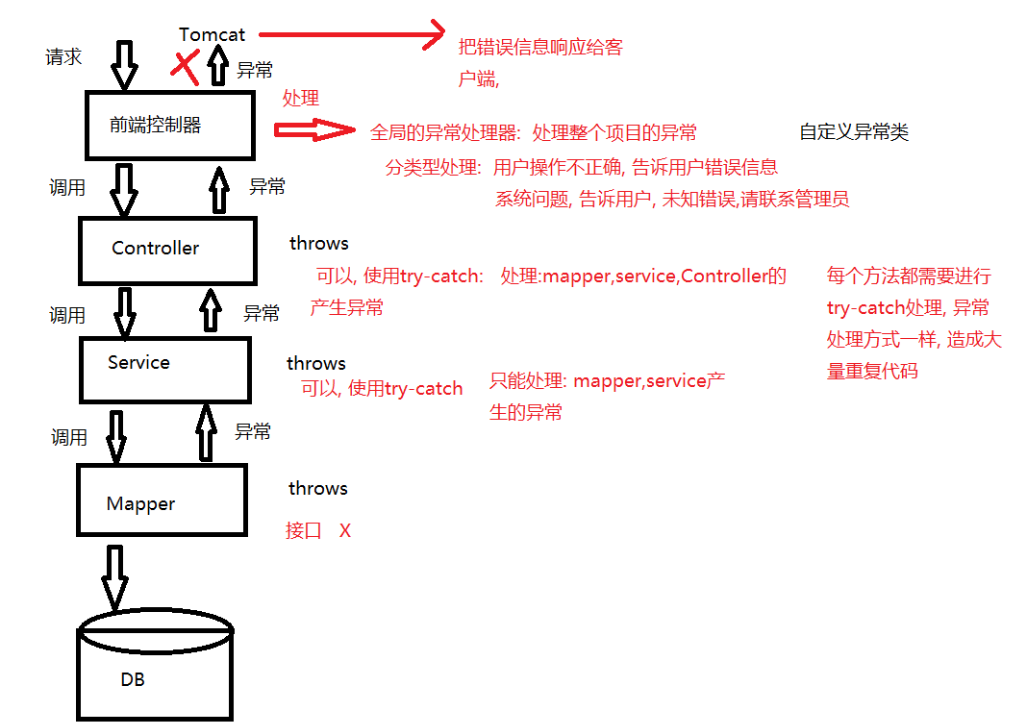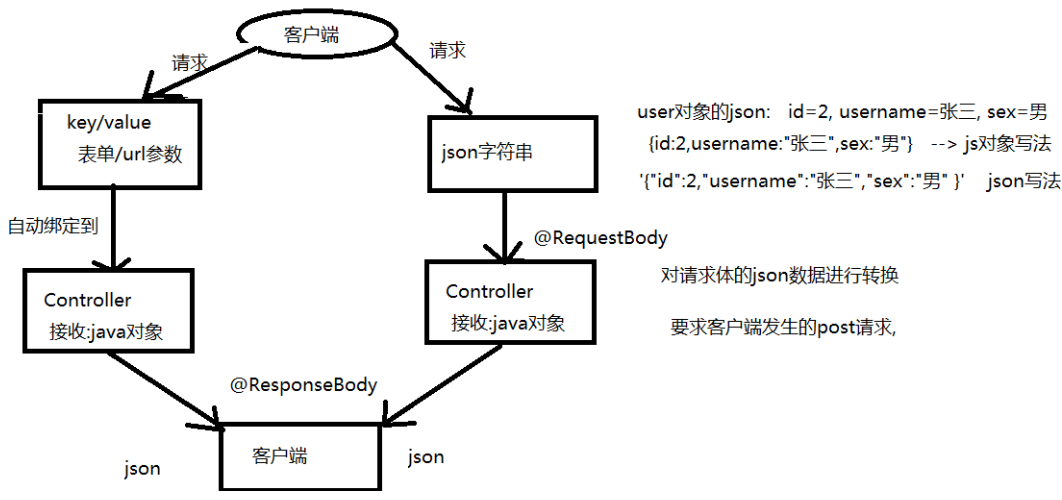一. 全局的异常处理器

1、编写一个自定义的异常类, 区分哪些异常是系统异常, 哪些异常是用户不正当操作的异常

//继承Exception public class UserException extends Exception{ private static final long serialVersionUID = -8469276157483476569L; public UserException() { super(); } public UserException(String message, Throwable cause, boolean enableSuppression, boolean writableStackTrace) { super(message, cause, enableSuppression, writableStackTrace); } public UserException(String message, Throwable cause) { super(message, cause); } public UserException(String message) { super(message); } public UserException(Throwable cause) { super(cause); }
2、编写一个全局异常处理器, 这个处理器必须实现HandlerExceptionResolver
//将异常处理类交给spring容器管理 @Component public class MyExceptionHandler implements HandlerExceptionResolver { @Override public ModelAndView resolveException(HttpServletRequest request, HttpServletResponse response, Object handler, Exception ex) { // ex 接收是抛出的异常对象 // 分类处理, 自定义异常, 直接响应 错误信息 // 系统异常, 响应的: 系统错误, 请联系管理员 ModelAndView modelAndView = new ModelAndView();if (ex instanceof UserException) {//用户异常 modelAndView.addObject("error", ex.getMessage()); } else {//系统异常 modelAndView.addObject("error", "系统错误,联系管理员!!!"); } modelAndView.setViewName("error"); return modelAndView; }
3、 在springMVC的配置文件中配置全局的异常处理器
①使用Component ②在springmvc配置文件中手动添加 <bean class="com.zl.house.exception.MyExceptionHandler"/>
4、扫描这个exception包中的注解
二、响应json支持

AJAX: 要求后台响应的是数据, 后台重定向,转发到一个页面, 把这个页面当成一个数据,响应给ajax,
后台: java对象
前台: ajax--> js对象, 使用json, 需要后台把java对象转换为json格式的字符串,
Servlet: 使用 json-lib, 手动调用JSONObject
SpringMVC转换json, 使用: 1)jackson *** 2) fastjson
1、导入jackson的依赖: 注意添加完把<type>bundle</type>删除,会附带导入所需要的jar
<dependency> <groupId>com.fasterxml.jackson.core</groupId> <artifactId>jackson-databind</artifactId> <version>2.10.0</version> </dependency>
Controller方法的返回值 java对象, 需要配合@ResponseBody, 把方法的返回值作为数据响应给前端, ****
如果是一个java对象,而且导入json的相关依赖(jaskson/fastJson), 调用转换器, 把java对象转换为json格式字符串响应给前端
把日期转换为 指定格式的字符串
@DateTimeFormat(pattern = "yyyy-MM-dd") // SpringMVC的注解, 把前端的字符串转换为Date
@JsonFormat(pattern = "yyyy-MM-dd") // jackson的注解, 把Date转换为json指定格式的字符串
@JsonFormat(pattern = "yyyy-MM-dd") private Date brithday;
忽略某个属性转换为json
@JsonIgnore private String password;
@RequestBody:主要用来接收前端传递给后端的json字符串中的数据的(请求体中的数据的),只能是post提交,get没有请求体
注解用于读取http请求的内容(字符串),通过springmvc提供的HttpMessageConverter接口将读到的内容转换为json、xml等格式的数据并绑定到controller方法的参数上。
//前端发送json, 响应json @RequestMapping("/queryUserByCondition.action") @ResponseBody public User queryUserByCondition( @RequestBody User user) throws Exception{ return user; }
前端代码
//请求的是json function requestJson(){ //请求参数是json // 默认情况下, data中json, 变成js对象, 变成key/value //contentType:"application/json;charset=utf-8", 改为json 格式的传输 $.ajax({ url:"${pageContext.request.contextPath }/user/queryUserByCondition.action", type:"post", //data:"id=2&username=张三&sex=男&brithday=1999-12-21", contentType:"application/json;charset=utf-8", data:'{"id":3,"username":"李四","sex":"男","brithday":"2012-12-12"}', success:function(rs){ alert(rs.username+"-->"+rs.sex); // json 字符串转换为js对象 }, dataType:"json" }); }
关与json注解无法传输session的解决办法
需要在返回类型为json的controller中存入session
@Controller @SessionAttributes({"user"}) public class LoginController { @RequestMapping("/login") @ResponseBody public Map<String,String> login(String name,String password,Model model,HttpSession httpSession) //将用户存入session域中 model.addAttribute("user", user); //返回一个map集合的json给前端页面 return map; }
注意:HttpSession httpSession务必要加上,不然会报错。
三、文件上传
1、对页面的要求:
- form 的method:post
- form的enctype: 默认值: application/x-www-form-urlencoded 一定设置为: multipart/form-data
- 上传文件的name属性,不能和后台接收的对象属性一样
- 使用<input type=”file”> 选择文件
2、对页面的要求:
导入文件上传的依赖: commons-fileupload commons-io
<dependency> <groupId>commons-fileupload</groupId> <artifactId>commons-fileupload</artifactId> <version>1.4</version> </dependency>
3、在springMVC配置文件上传的解析器
<!-- 文件上传 --> <bean id="multipartResolver" class="org.springframework.web.multipart.commons.CommonsMultipartResolver"> <!-- 设置最大的上传文件大小 :10M--> <property name="maxUploadSize" value="10485760"></property> </bean>
注意:bean的id一定为multipartResolver,否则获取不到数据
4、前端代码
<form action="${pageContext.request.contextPath }/user/addUser.action" method="post" enctype="multipart/form-data"> //上传文件的name必须和对象对应的属性不一样,否者报400 头 像:<input type="file" name="photo" /> <hr /> <button>添加</button>//button默认是submit提交 </form>
5、文件代码
@PostMapping("/addUser.action")
public String addUser(User user, MultipartFile photo,Model model) throws Exception{
if(photo == null) {
throw new UserException("请选择图片");
}else {
//保存文件
String savePath = "D:\upload";
//File类
File pathFile = new File(savePath);
if(!pathFile.exists()) {
//创建文件夹
pathFile.mkdirs();
}
//文件名取名: 时间戳 UUID
//获取上传文件的后缀名
String uploadFileName = photo.getOriginalFilename();
String suffix = uploadFileName.substring(uploadFileName.lastIndexOf("."));
String saveFilename = UUID.randomUUID().toString().replace("-", "").toUpperCase()+suffix;
//保存
photo.transferTo(new File(savePath,saveFilename));
//给user对象的photoPath属性赋值
user.setPhotoPath(saveFilename);
//调用业务层,保存用户
userService.saveUser(user);
model.addAttribute("msg", "保存成功");
}
return "msg";
}
页面显示:https://www.cnblogs.com/64Byte/p/12925721.html
<img src="/img/${user.photoPath }"/>
需要在tomcat中配置映射路径

6、页面显示:获取对象,没有对象显示默认页面
<img src="<c:choose> <c:when test="${empty house.photopath }">${pageContext.request.contextPath }/images/thumb_house.gif</c:when> <c:otherwise>/img/${house.photopath}</c:otherwise> </c:choose>"width="100" height="75" />
